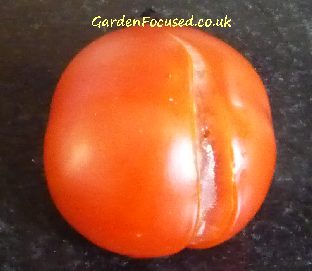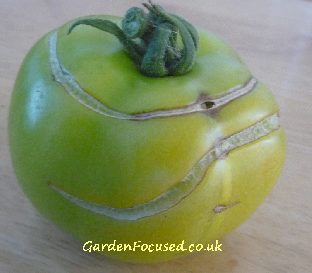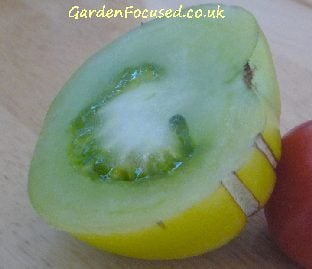It’s important to understand that the problem is not caused by tomato pests and diseases, it’s caused by growing conditions alone.
WHY DO TOMATOES SPLIT?
They split because the flesh inside the skin expands quicker than the skin itself. This puts pressure on the skin and can eventually lead it to tear or split. Tomatoes normally start to split when they are nearly fully grown and the ripening process is about halfway to completion. The picture below shows a ripe tomato which has split. This should be picked and used immediately because the split is open and just waiting to be infected.
Under ideal conditions the growing and ripening cycle of a tomato fruit tends to slow down as it reaches full size, and as this happens the skin thickens slightly making it less elastic. If, at this point in the growing cycle, a period of dry, warm weather occurs and is then followed by an abnormally wet, warm period the tomato may start into full growth mode again without the thickened skin being able to expand resulting in split skin.
The picture below shows an unripe, green tomato which has split but the split part has a callous on it which should allow it to grow successfully until it is ripe.
HOW TO PREVENT TOMATO SKINS FROM SPLITTING
Preventing the splitting from occurring sounds simple – provide a regular supply of supply of water without water-logging the plants. However the growing method will influence how best to do this. There are three main methods for growing tomatoes outside and maintaining a good water supply for each is described below:
-
GROWING IN OPEN GROUND
This is the most difficult situation for controlling the moisture at the roots because there is very little you can do to stop the effects of large amounts of rainfall. On the plus side however, the ground is likely to remain moist for a relatively long period even in dry periods. We suggest applying a mulch around, but not touching, the base of the tomato plant in late June time at the latest. This will prevent water from evaporating quickly in dry periods. Water in hot and dry periods.
-
GROW-BAGS
The amount and frequency that water enter a grow bag full of tomato plants is almost entirely under your control. Even prolonged periods of heavy rain will result in very little rain water entering the bag. Water frequently to keep the compost moist but not water-logged. It is extremely difficult and time-consuming to get compost to absorb water when it has dried out.
-
CONTAINERS
The same rules apply to containers as to grow bags. Containers are in fact worse as far as even watering is concerned because moisture is constantly evaporating from the top of the pot. Cover the top soil in the pot with a thick layer of mulch to reduce evaporation. The larger the container the easier it is to maintain an even supply of moisture at the roots.
If you still find it difficult to stop your tomato skins from splitting then an alternative method of preventing it from happening is to harvest them before they are fully ripe. The best stage to do this is when they begin to turn from green to their final colour. The fruits can then be ripened on a sunny window sill or in a warm greenhouse. Tomatoes do not need light to ripen but they do need some warmth which is the reason they are often ripened on a windowsill.
The act of picking them before they are ripe will immediately cut off the water supply to the fruits and stop them expanding further. Tomatoes ripened on window sills and similar places taste every bit as good as those which are ripened on the plant.
As far as different tomato varieties are concerned there is no clear evidence that any of them is more resistant to cracking than others. If you look at the seed merchants catalogues you will always find that some (but not the same) varieties are supposed to resist cracking but no evidence to back this up. We suggest you stick to the variety you prefer, water regularly and pick the fruit early as described above.
ARE SPLIT TOMATOES SAFE TO EAT?
Tomatoes split because of an uneven water supply not because they have a pest or disease. If all that is wrong with a tomato is a split skin then it is safe to eat raw or cooked. Clearly, if you use some tomatoes for freezing or in chutneys, purees etc. then it’s a good idea to use the split ones first where their imperfect appearance will not be seen.
The picture below shows the flesh of a green tomato which has split skin. As you can clearly see, although the skin of the tomato is disfigured the flesh inside is in perfect condition. This tomato would be fine to eat if left to ripen.
Common pests and diseases which affect tomato fruits grown outdoors include:



WHY DO TOMATO SKINS SPLIT?
By David Marks
Home grown tomatoes not only taste delicious but they should also look attractive to eat. Having a split in the skin does not affect taste but it definitely does spoil the appearance especially with cherry tomatoes which may well not be sliced. Luckily, avoiding split tomatoes is not difficult to achieve if you understand the reasons which cause it to happen. The important factors are correct and frequent watering, the variety of tomato and the ripening process.